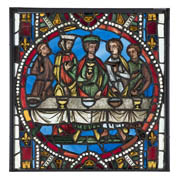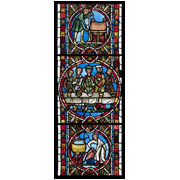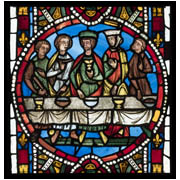Details
- Object type
stained glass panel
- Title
A Feast Scene
- Place Associated
France, Clermont-Ferrand (place of manufacture)
- Date
circa 1255-1285
- Materials
white, coloured, stained and painted glass, lead
- Dimensions
overall (approx): 640 mm x 620 mm x 10 mm; framed 640 mm x 620 mm x 32 mm
- Description
-
This rectangular panel comprises three panels (see 45.366.a-c) - one depicting a man using bellows to fan a fire beneath a suspended cooking pot; one depicting a man watching over a cauldron; and one showing four men and a woman grouped on the far side of a table covered with a diapered white cloth, and laid with three platters and two drinking cups. The focus of the feast is seated in the centre wearing a turban type head-dress and a yellow lined mantle over a green belted tunic and yellow shoes, there is a man on his right and a woman on his left. He holds a goblet while the man makes a blessing gesture with his right hand and points vigorously downward in a diagonal direction with the other. On either side is a servant, one holding a phial and the other pointing upward.
The roundels have a blue ground and are bordered by a band of red lined with white dots. Between them the spaces are filled with red, yellow and green glass and linking quatrefoils outlined in white dots which are also used for the inner side of the vertical borders where yellow castles in a red ground alternate with yellow fleurs-de-lis in a blue one.
This panel was acquired as depicting the Marriage at Cana, the event during which Jesus turned water into wine, or coming from a larger window depicting this story. William Wells suggested that the episode represented is either the moment when the ruler of the feast is told that the wine is finished or when he is being given a taste of the miraculous wine. He considered the smaller roundels with cooks the donor's signatures.
However, more recent scholars have suggested that the subject may simply be a courtly feast. This title has been given to a further very similar panel of almost identical dimensions in the Memorial Art Gallery Rochester.
Both panels are believed to have been removed from the Cathedral at Clemont-Ferrand. Its windows are closely related to the important windows of the Parisian Sainte-Chapelle - in their density, form, and stacking of medallions on top of one another, as well as diapered ground surrounded by a thin border. There are also similarities in medallion shape, composition, figure type, and iconography.
These parallels are often attributed to the fact that Hugues de la Tour, Bishop of Clermont in the late 1240s, attended the dedication of the Sainte-Chapelle in Paris. Helen Zakin has argued that it is possible that the workshop which made these windows was established by a stained-glass craftsman who had worked at the Sainte-Chapelle, perhaps using sketches showing the basic compositions of the Parisian windows, medallion and ornament shapes. This has been named as the St John the Baptist atelier and was responsible for the first glazing programme at Clermont Ferrand.
However, this glass also differs from the Parisian glazing on account of the simple strong colouration dominated here by blue and red. A reduced and strengthened colour palette was well suited to the vast proportions and black volcanic stone of the Cathedral at Clermont Ferrand. There, gold fleurs-de-lis on blue panels, and gold castles on red panels, making up a thin border on either side of the medallions is a particular signature motif found in the windows in the cathedral’s St John the Baptist chapel.
As Burrell himself observed in his purchase book – a type of jotter in which he recorded everything about his buys – the fleur-de-lis was the attribute of French kings, and gold castles were the arms of Blanche of Castile, wife of Louis VIII and mother of St Louis. These were a common decorative motif in the second half of the thirteenth century.
Provenance: Ex-Hearst Collection (lot 99 art. 28). Bought by Sir William Burrell from Frank Partridge and Sons, 13 February 1939 for £1000.
- Credit Line/Donor
Gifted by Sir William and Lady Burrell to the City of Glasgow, 1944
- Collection
Burrell Collection: Stained Glass
- ID Number
45.366.b
- Location
Burrell Collection





